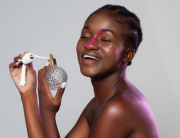Art is a form of peaceful expression allowing artists to tell stories and spark revolutions through a canvas or a blank space. Dr. DeLorean Griffin is emphatic that art is his resting place and first love. So, it’s no coincidence that he channeled his admiration of art and design into the medical field. The highly sought-after surgeon is a board-certified plastic and reconstructive surgeon whose foundational philosophy is health first, then positive body image. He stopped to talk with SHEEN Magazine about his journey through medicine and gave us an inside scoop on popular surgical procedures.
SHEEN: You are the Doctor in very high demand. Please walk us through how your path led you to plastic surgery. Was this field of work by accident, or is this what you dreamt of becoming?
Dr. Griffin: Starting from college at Florida A&M University, I was initially a graphics arts major, but I never really saw that as a career path that would be sustainable. You always hear about starving artists, but how often do you hear of starving doctors? So I changed my course of study to pre-med and biology. I was still determining which path I wanted to take. Finally, I knew I wanted to have a career in medicine.
Although I started without medical mentors at FAMU, several family members encouraged me to become a doctor. As a result, I took the MCAT and was fortunate enough to get accepted into Wayne State School of Medicine in my hometown of Detroit. By then, I had latched onto several African-American doctors who provided mentorship and played an intricate role in my preparation for medical school.
Like most college students, I remained uncertain, and I was still determining which field of medicine I wanted to go into. My classmates recognized my artistic ability and said I needed to be a medical illustrator or a plastic surgeon. So I latched on to a mentor, Dr. Bala, who showed me everything plastic surgery was about, from reconstructive to cosmetic and surgical techniques. When I decided to practice general surgery, I was in the middle of medical school. I did five years of residency at Detroit Medical Center (DMC). While there, I operated on various trauma patients, including gunshot victims, burns, stabbings, etc. The hectic life of general surgery intruded on my mental health and quality of life, allowing me to start my pathway into plastic surgery.
After eight years at DMC, I practiced reconstructive and plastic surgery at St. Mary’s Hospital in Livonia for six years. My positive reputation and bedside manner caused my practice to take on a life of its own, and my clientele increased drastically. Finally, it was time for me to open a private practice, and in 2021 Griffin Plastic Surgery was born! Our practice doors have been open for over a year, and we’ve been thriving ever since.
SHEEN: Let’s talk stats. What is the percentage of African-American men who are in this field? Dr. Griffin: I was fortunate enough to train in one of the country’s most, if not the most, diverse programs. But the answer is about two percent for African-American males. I learned these stats at our plastic surgery conference in 2021. Unfortunately, the numbers are even lower for African American women. This is why representation matters.
SHEEN: You recently started your practice. What was this journey like for you, and what were some hurdles you had to overcome?
Dr. Griffin: Residency teaches you surgical knowledge and how to be an excellent technical surgeon, but none of it teaches you the business aspect of medicine. None of that is taught in terms of employing people, having payroll, having expenses, overhead, managing these things, and being a fair employer. I thank God I could hire an amazing team that adds value to my practice. Because I started as an employed physician, I picked up on many things that allowed me to become a practicing plastic surgeon first, then pick up the business pearls. That was one of the biggest hurdles.

SHEEN: What is your special field of practice, or can you perform any surgery?
Dr. Griffin: Most plastic surgeons have a niche because the field of plastic surgery is so broad. Some plastic surgeons will only perform cleft palates for children. Some will only perform breast augmentation, etc. Most of us can do these things, but we focus on a few body parts that we excel at to enhance our field. I mainly perform breast and body, which consists of breast augmentation, breast reduction, tummy tucks, and fat transfer to the butt, known as the Brazilian Butt Lift (BBL). I started my career performing post-bariatric body contouring, including for those who have had weight loss and have hanging skin that needs tightening up, which is a big part of my practice.
SHEEN: When do you say no, I can’t perform this procedure?
Dr. Griffin: The goal is not achievable when they have unrealistic expectations. It often boils down to having the proper BMI, diet, and exercise routine. I conduct a physical and psychological assessment before performing any procedure.
SHEEN: Do you recommend people who want to augment certain parts of their body to exercise?
My philosophy is to go to the gym and see if you can achieve your goals, then come and see me. Everyone has areas of their body they would like to change if they could. For example, I frequent the gym, but I would like to have more defined abs. But if you go to the gym beforehand, you will have great results from the surgery in terms of health and maintenance.
SHEEN: How many surgeries do you perform in a week?
Dr. Griffin: I’m very intentional about not overextending myself and ensuring that I provide excellent patient care; if I have a long surgery, that will be the only surgery I perform for that day. My surgery schedule varies and changes from week to week.
SHEEN: What words do you offer your patients for them to have a healthy and positive body image?
Dr. Griffin: I want my patients to do it for themselves first and foremost because nothing else matters without improving your image of yourself. Again, everyone has insecurities and has something about themselves that they would like to change. If it’s healthy, then I am all for it.
SHEEN: How do you balance living, and what do you do for self-care?
Dr. Griffin: Absolutely, my artwork. That is my ultimate escape and my way of achieving catharsis. After that, I want to get into sculpting.
SHEEN: Is there a future in teaching for you?
Dr. Griffin: I’m an associate professor at Wayne State University and Detroit Medical Center for the program I trained in. I also teach and mentor throughout metro Detroit.
SHEEN: Do you think you’re living your true purpose?
Dr. Griffin: Absolutely. My true purpose comes through artistry and improving the lives of others.
Website: www.griffinplasticsurgery.com
Instagram: griffin_plastic_Surgery







Add Comment
You must be logged in to post a comment.